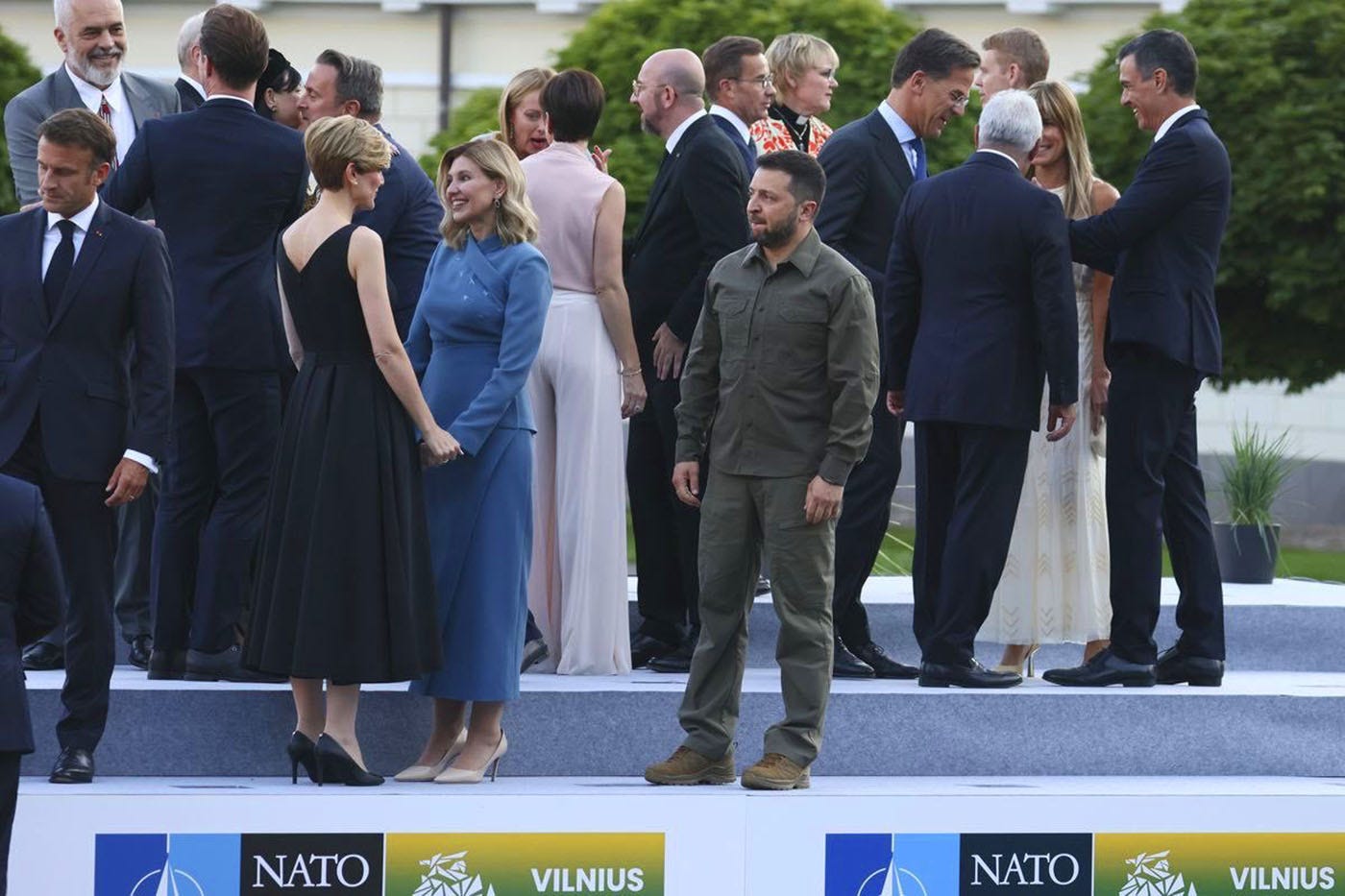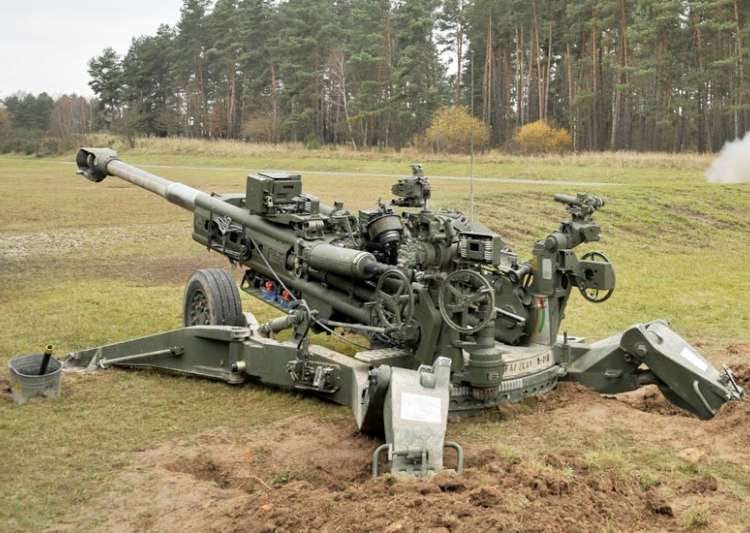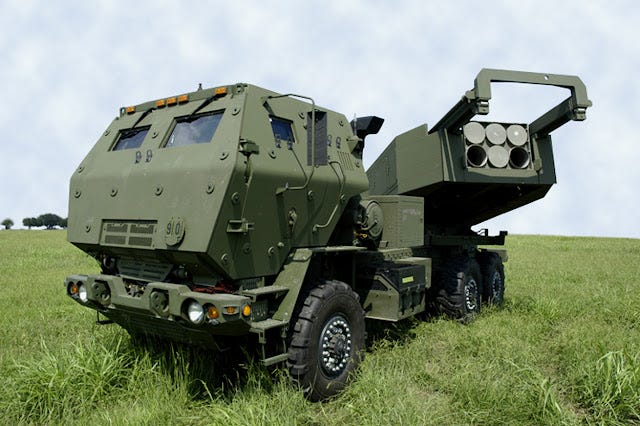The Jig Is Up
This is how empire ends: not with a bang, but a whimper.
The member nations of the North Atlantic Treaty Organization — consisting of the teetering Masters of Empire and their tawdry entourage of class-stratified vassals — have just concluded a historic confab in Vilnius, Lithuania, capital of the alpha Baltic chihuahua.
In a shockingly transparent but otherwise rather banal series of events it became unmistakably clear that their grand plans to subject Russia to the “rules-based order” have come to naught.
Among others, the following consequences will ripple in the wake of this reality:
Russia will achieve a decisive conclusion to the war on terms they dictate.
NATO is shattered as a military alliance, and coming apart at the seams as a political alliance.
Germany is on a trajectory of becoming a failed state, and as it goes, so will go the incoherent iron and clay mixture of the so-called European Union.
The great myth of overwhelming US armaments supremacy has been exposed as little more than a modestly scaled boutique enterprise utterly ill-suited and ill-prepared to prosecute industrial warfare against a peer adversary.
Of course, many will immediately object:
“But the US hasn’t even employed its military in Ukraine! If the US entered this war with its awesome air and naval power, and its “best-in-class” army … well, the Russians would get pounded to dust within a few weeks.”
Well, I hope the thesis is never put to the test, because it will NOT end well.
I am now more convinced than ever that Russia’s specific strengths match and will consistently defeat the American military’s perceived strengths.
Russia admittedly does not wield an expeditionary military, but the concept and constitution of the military it has built renders it effectively unbeatable in its own neighborhood.
A little over a year has now passed since I published an essay entitled The United States Could Not Win and Will Not Fight a War Against Russia. I have recently revisited it. I felt no impulse to change a thing. Indeed, I am struck by how much it is more apropos now than it was a year ago. I believe it constitutes an essential element of understanding in relation to the geopolitical realities at work in our world circa 2023.
Since I wrote the article, there have been many twists and turns in the path of the continuing quasi-proxy war in Ukraine between the rapidly descendant American Empire and an increasingly resurgent Russia. But in early July 2022, it had, in my estimation, become undeniably evident that Russia had effectively wrecked the formidable original proxy army the empire had built, trained, and partially equipped on the foundation of Ukrainian flesh and blood, and a substantial collection of legacy Soviet implements of war.
Sure, there were still scattered potent remnants, but it had been degraded at least 60% by that point in time. Despite a few own-goals along the way, the Russians accomplished this using a force less than half the size of the one the Ukrainians arrayed against them, while inflicting severe equipment losses and at least a 7 to 1 casualty ratio.
So NATO was forced to up the ante. Aspiring to address the obvious Russian advantage in firepower, they shipped several batteries of M-777 155 mm howitzers to Ukraine, followed soon by a few dozen M-142 HIMARS rocket launchers.
Both weapon systems enjoyed a smattering of early successes that were ecstatically trumpeted by western media and their devout disciples around the world.
Meanwhile, tens of thousands of Ukrainian young men were being trained in NATO bases dotting Europe and the western hemisphere. They were instructed in the use of NATO equipment, and to fight the Russians according to NATO battlefield doctrine.
By mid-summer, a significant portion of this second iteration of the Ukrainian army had arrived back in Ukraine, along with hundreds of NATO infantry vehicles, mountains of ammunition — and perhaps most significantly — a substantial contingent of NATO-affiliated “volunteers” from many countries within the western alliance, notably Poland.
I am persuaded this escalatory step convinced the Russians they must immediately begin to more fully prepare themselves for the prospect that NATO would directly intervene in the war.
First they gave priority to learning how best to track down and destroy the limited-mobility M-777 howitzers. And rather than obsess unduly on targeting the elusive HIMARS launcher vehicles, the Russians instead focused on electronically jamming / spoofing the GPS sensors or otherwise shooting down the rockets with their short- and medium-range air defense systems.
(Their success in this respect has been nothing short of a revolution in military affairs. It is unprecedented in the age of aerial warfare. Yes, some missiles still get through, but not many, and typically only in the absence or on the outskirts of Russian ECM and air defense coverage areas.)
The Russians had, throughout early- to mid-2022, made significant offensive advances into the Novorossiya regions of Kherson, Zaporizhzhia, Donetsk, Lugansk, and Kharkov. But as the summer waned, they began to perceptibly consolidate the entire line of contact. They then quickly brought to pass popular referenda in all but the Kharkov region — thereby formally assimilating the other four into the Russian Federation.
In mid-August 2022, the AFU began to advance against Russian forces on the western borders of the Dnieper River near Kherson. The Russians savaged the initial attacks, but then assumed a tactical-retreat posture. This continued for many weeks as they methodically contracted their lines into a bridgehead on the western part of Kherson city proper, all the while exacting severe losses on the attacking forces.
They would eventually effect an almost-flawless evacuation of twenty thousand troops and virtually all their heavy equipment to the eastern bank of the river, blow up the Antonovsky bridge, and then proceed to methodically destroy the AFU equipment, ammo, and troops on the other side with artillery and airstrikes that continue to this day.
As September rolled around, the Ukrainians (with significant numbers of NATO-affiliated “volunteers” in the vanguard) moved with an even more potent force in the Kharkov region, aiming for the strategic cities of Kupyansk, Izyum, and Kremmenaya.
Again, amid much triumphalism in the western punditsphere, as well as bitter recrimination and hyperbolic dooming from the Russian sixth column and its acolytes, the Russian high command effected what I observed to be an orderly, well-executed fighting retreat to the other side of the Oskol river, where they had prepared fortified lines and installed substantial reinforcements.
At that point, the Ukrainian offensive in the Kharkov region reached its high-water mark, and as autumn turned to winter and then to spring, every attempt to advance further — and there were a great many — was met with a decisive repulse.
Though consistently ignored by those who laud the “lightning advances” of the late-season AFU “counter-offensive” in Kharkov, the attacking Ukrainian forces were horrifically mauled between the first week of September and mid-October — and ever since.
As the Russians contracted their lines to much more defensible positions, they concurrently mobilized and commenced intensive training of several hundred thousand reservists and new volunteers; ramped up armaments production to completely unforeseen levels, and settled in for the next few months to fight a punishing war of attrition against Ukraine and its NATO benefactors — even as they simultaneously prepared to face the credible possibility of direct NATO intervention.
That said, despite a mostly defensive posture throughout late 2022 and early 2023, the Russians did launch an operation against the strategic cities of Soledar and Bakhmut that few foresaw would evolve into the bloodiest battle on European soil since the Second World War. “Surovikin’s Meat Grinder” would eventually consume many tens of thousands of Ukraine’s best remaining troops and equipment.
In the end, the second iteration of the Ukrainian army was degraded even more comprehensively than was the first.
Ukrainian air power has long-since been rendered effectively negligible. Provided with occasional but very sparse deliveries of old Soviet aircraft from the former Warsaw Pact nations, they have continued to manage occasional stand-off missile strikes, but close air support has been nonexistent.
Russian missile strikes on Ukrainian infrastructure in early 2023 served to rapidly deplete the legacy Soviet air defense systems. And all western shipments of would-be replacements have proven to be inferior to Ukraine’s old stocks of S-300 and Buk systems.
Fantastical Ukrainian and western media claims of 90%+ shoot-downs of Russian missiles notwithstanding, the Russians now routinely strike targets throughout Ukraine where and when they will.
Most debilitating of all, persistent ammunition shortages have now become acute. Original and supplemented stocks of Soviet-sized 152 mm artillery are nearly exhausted. And despite the US having coordinated the shipment of millions of NATO 155 mm artillery shells from every nook and cranny in the empire’s vast global network of bases and those of its obedient vassals, the cupboard is now bare.
What was widely (albeit fallaciously) believed to be a nearly inexhaustible supply of equipment and ammunition in the warehouses of the Pentagon and its various less-than-sovereign minions around the globe has been exposed as entirely inadequate to the demands of a real war.
It is an astonishing revelation in the eyes of a great many in the world.
And yet, it shouldn’t be.
In my July 2022 article, I prominently cited US Army Col. (Ret.) Alex Vershinin's all-important analysis regarding The Return of Industrial Warfare, which had appeared in RUSI a couple weeks previous. If you have not already done so, I highly recommend this short but powerful essay. His entire argument has now been confirmed by events.
Here in mid-July 2023, almost everything that eighteen months ago was only seen through a glass darkly is now undeniably apparent to all with eyes to see:
Far from being massively attrited, as any number of empire-compromised NATO rent-a-generals and politicians have ludicrously argued from the first weeks of the war, the Russians have employed an extremely impressive economy of force to achieve their objectives. To be certain, they have suffered losses in men and equipment that would be far in excess of anything western nations could abide. But the fact remains that the Russians have inflicted the most disproportionate casualty ratio of any major war in the modern era.
My sense of the matter is that the aggregated total of Russian, Donbass militia, and PMC Wagner combat deaths is probably in the neighborhood of twenty-five thousand.
On the other side of the line, Ukrainian combat deaths are now almost certainly in the range of 250k to 350k – at least 20k of that total occurring just since the first week of June.
The third iteration of the Ukrainian army, equipped predominantly with imported NATO armor, artillery, and ammunition, has been torn to shreds over the course of the previous six weeks of their last gasp offensive. The AFU very likely has been husbanding its scant remaining stock of NATO equipment and ammunition for one last “charge of the damned”, but otherwise Ukrainian offensive potential is played-out, and there will be no fourth iteration of a Ukrainian army to face the Russians on the field.
Meanwhile, upwards of four-hundred thousand uncommitted Russian reserves are champing at the bit to be turned loose. With Russian military industrial output now in high gear, these troops are better-equipped than any that have yet taken part in this conflict.
The Russian air force has received substantial numbers of new airframes from the production line. Attack helicopters roam the battlefield with near-impunity. Russian supply of strike drones, cruise missiles, and supersonic air-launched missiles appears to meet all its battlefield demands. Its so far modest deployment of hypersonic missiles has shown them to be extremely potent weapons that defy the attempts of antiquated western air defenses to interdict them.
This war is a lost cause for the empire and its hapless allies in Europe and around the world. And that, of course, is the unavoidable conclusion that has finally managed to seep into the otherwise dense skulls of the various participants at the recent NATO summit in Lithuania.
The Masters of Empire now face a no-win scenario. They must abandon their failed Ukraine gambit — and inexorably, over the next few years, yield to maximalist Russian demands regarding the roll-back of NATO to its pre-1997 borders — or else yield to the mad impulse of a futile attempt to subjugate Russia by force of arms in the form of direct US/NATO intervention into this war.
Either way, the decline of the empire will be radically accelerated; NATO will almost immediately cease to function as a credible military/political alliance; the EU will dissolve as a monetary/political "union"; the demise of the global dollar system will rapidly gain momentum.
And though many, if not most, find risible the assertion that these things could possibly come to pass in anything like the near- or medium-term (2 - 5 years), I increasingly expect they will be proven catastrophically mistaken.




